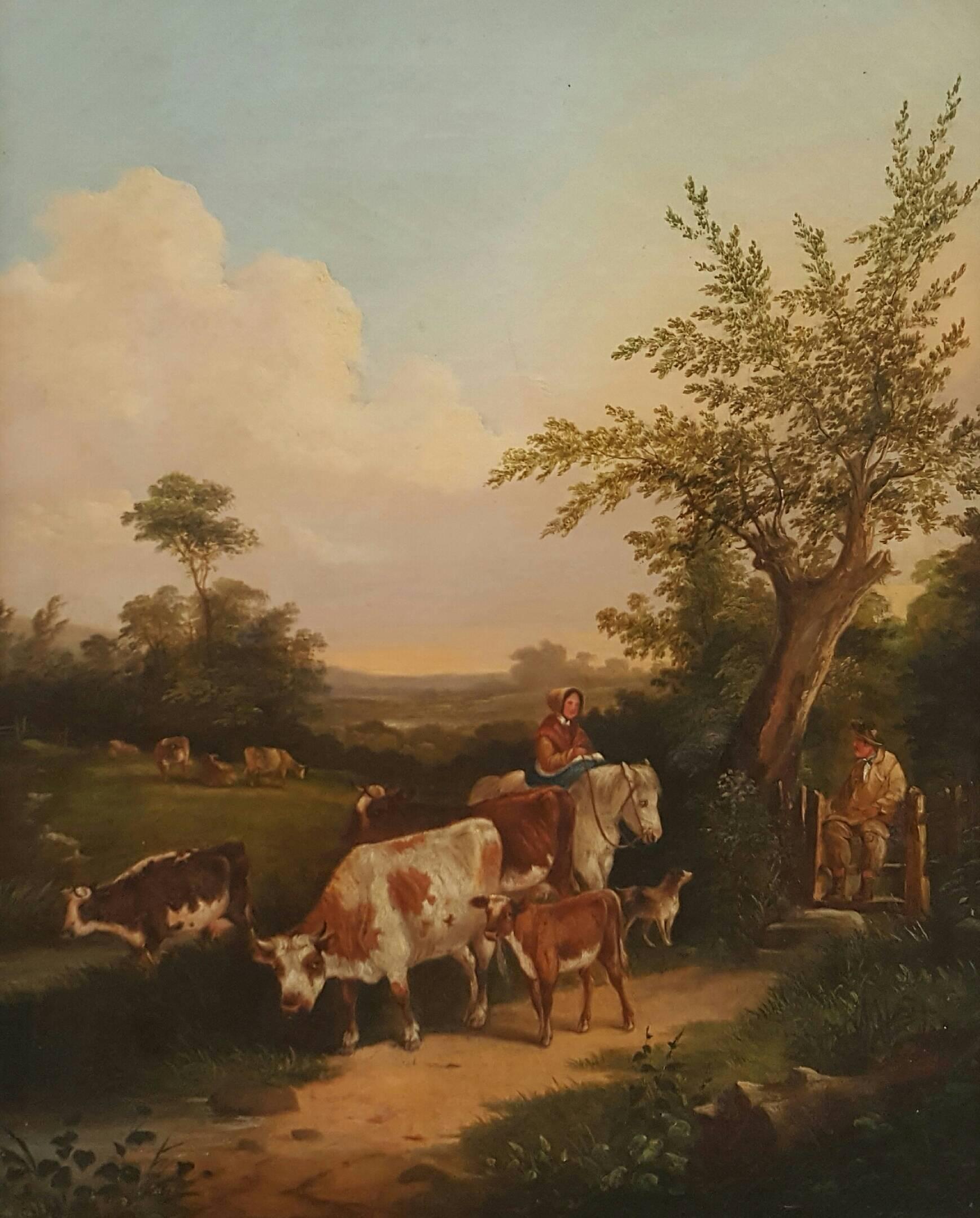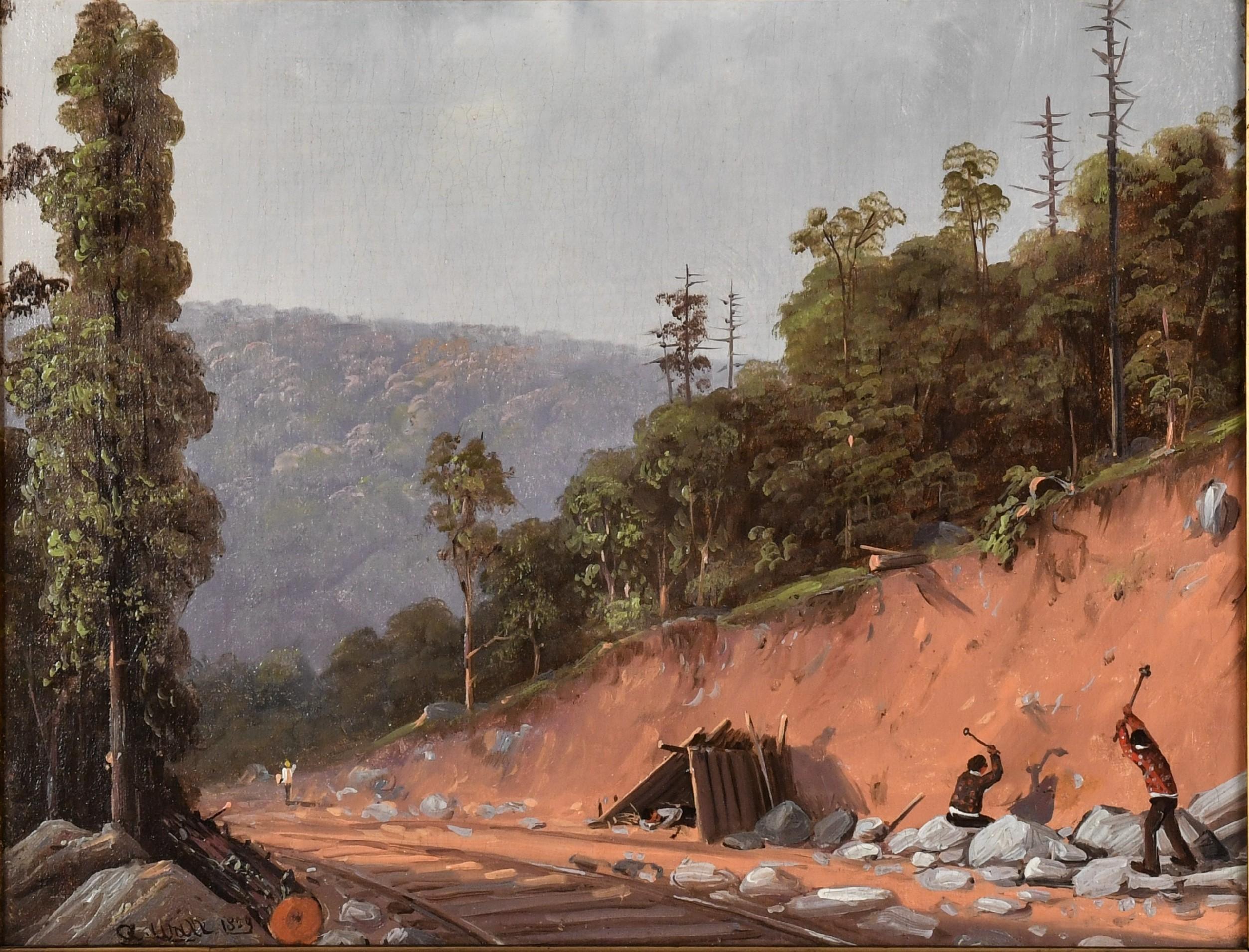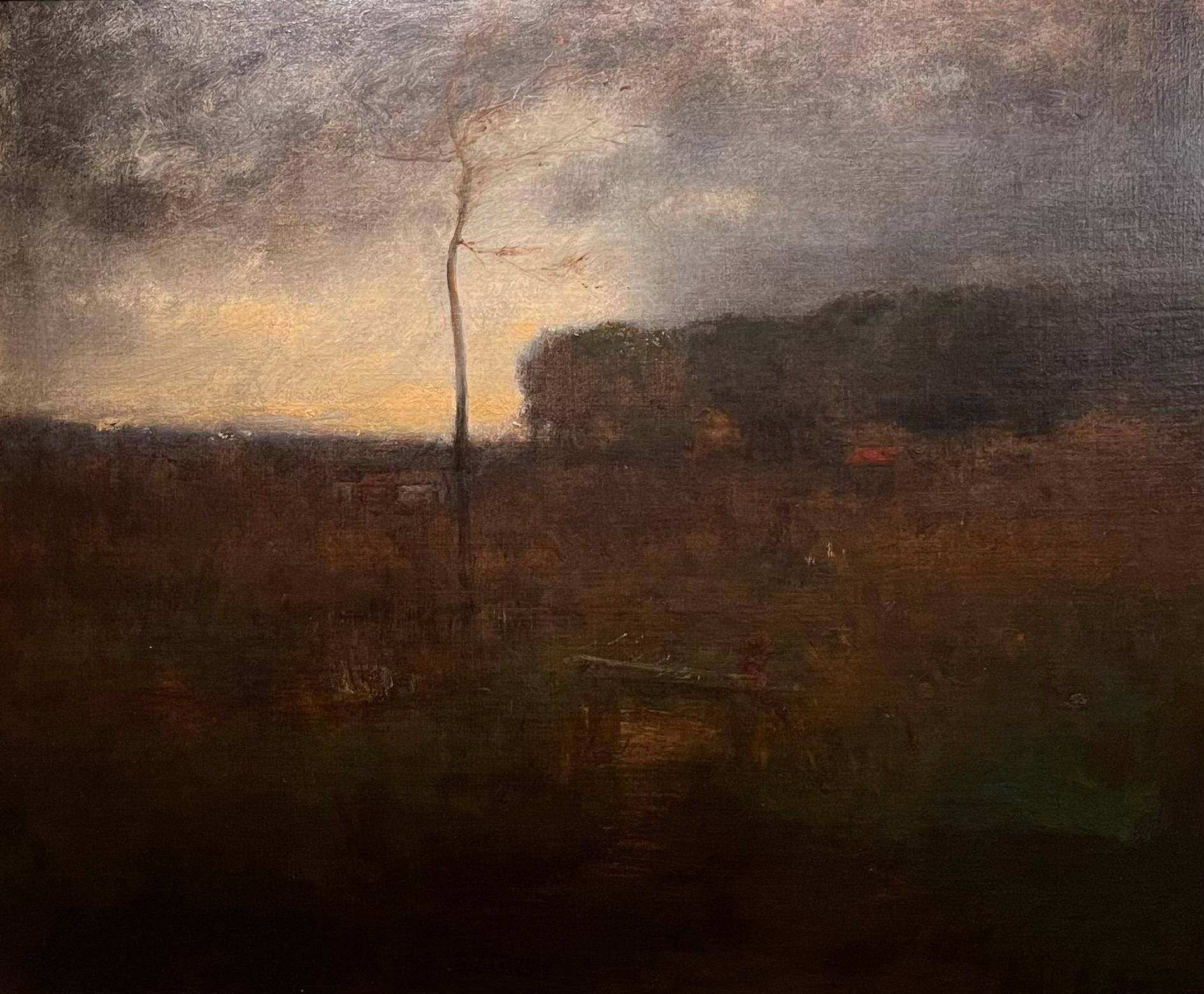Items Similar to Antique American School 19th Century Nautical Seascape Sailboat Oil Painting
Want more images or videos?
Request additional images or videos from the seller
1 of 10
UnknownAntique American School 19th Century Nautical Seascape Sailboat Oil Painting1880
1880
About the Item
Impressive 19th century seascape. Oil on canvas. Housed in fine fluted cove contemporary giltwood frame.
- Creation Year:1880
- Dimensions:Height: 24 in (60.96 cm)Width: 29 in (73.66 cm)Depth: 2 in (5.08 cm)
- Medium:
- Movement & Style:
- Period:
- Condition:
- Gallery Location:Buffalo, NY
- Reference Number:1stDibs: LU139213911972
About the Seller
4.9
Platinum Seller
These expertly vetted sellers are 1stDibs' most experienced sellers and are rated highest by our customers.
Established in 1970
1stDibs seller since 2015
2,385 sales on 1stDibs
Typical response time: 1 hour
- ShippingRetrieving quote...Ships From: Brooklyn, NY
- Return PolicyA return for this item may be initiated within 2 days of delivery.
More From This SellerView All
- Antique Signed American Impressionist Framed Panoramic Blazing Sunset PaintingLocated in Buffalo, NYAn antique American oil painting in its original period frame. This tonalist work features a stunning luminescent quality of the sun reflecting off a lake surrounded by trees. Thi...Category
1890s Hudson River School Landscape Paintings
MaterialsCanvas, Oil
- Antique American School Impressionist Sunset Hudson River School Oil PaintingLocated in Buffalo, NYAntique American Hudson River School sunset landscape oil painting. Oil on canvas, circa 1874. Signed in monogram. Housed in a giltwood frame. Image size, 30L x 22H.Category
1870s Hudson River School Landscape Paintings
MaterialsCanvas, Oil
- Antique American School Impressionist Forest Interior Giltwood Frame PaintingLocated in Buffalo, NYAntique American landscape oil painting. Oil on canvas. Framed. Image size, 11L x 9H.Category
1890s Hudson River School Landscape Paintings
MaterialsCanvas, Oil
- Romantic American School Fall Forest Interior Impressionist Framed Oil PaintingLocated in Buffalo, NYAntique American impressionist fall forest oil painting. Oil on canvasboard. Finely painted and housed in a period giltwood frame.Category
1890s Hudson River School Landscape Paintings
MaterialsCanvas, Oil
- Antique American Sunset Landscape Hudson River School Framed Oil PaintingLocated in Buffalo, NYImportant framed 19th century Hudson River School landscape. Possibly estate stamped. Housed in an impressive period frame. Oil on canvas.Category
1860s Hudson River School Landscape Paintings
MaterialsCanvas, Oil
- Antique American Hudson River School Colosseum Italian Oil Painting LandscapeLocated in Buffalo, NYAntique American Hudson River School artist working in Italy. Oil on canvas. Framed nicely. No signature found.Category
1860s Hudson River School Landscape Paintings
MaterialsCanvas, Oil
You May Also Like
- A Summer GatheringBy Ambrose AndrewsLocated in Saratoga Springs, NYSigned lower right. An itinerant portrait, miniature, and landscape painter, Ambrose Andrews had a wide-ranging career geographically that saw him in many regions including New York (1829-31), Connecticut (1837), Texas (1837-1841) and Louisiana (1841-42). After 1844, he was active in St. Louis, New York City, Buffalo, New York, Vermont and Canada. He was born in West Stockbridge, Massachusetts, and in 1824, attended the National Academy of Design. Andrews exhibited paintings at the Republic of Texas Capitol...Category
19th Century Hudson River School Landscape Paintings
MaterialsCanvas, Oil
- "Building the Allegheny Railroad, Pennsylvania" Alfred Wall, Scalp Level SchoolLocated in New York, NYAlfred S. Wall (American, 1825-1896) Untitled (Building the Railroad), 1859 Oil on canvas 14 1/2 x 18 1/2 inches Signed and dated lower left For Christmas, 2008, the Pittsburgh Post-Gazette featured Alfred Wall's painting, Old Saw Mill from the collection of the Westmoreland Museum of American Art in Greensburg, PA. It was painted in 1851 in the town of Lilly, Pennsylvania in the Allegheny Mountains. The newspaper description stated that "though the saw mill is long gone, it still conveys all the warmth and coziness of this time of year. The article, written by Patricia Lowry, continued: At first glance, Alfred S. Wall's painting of a saw mill in snowy woods triggers nostalgia for the coziness of a log cabin, the smell of a wood-burning fire and the warming of chilled hands and feet beside it. But as sentimental as it seems on the surface, Mr. Wall's painting has a deeper and unexpected context. This is more than a painting about sled-riding children and early industry planted in the middle of virgin forest. Intended or not, this is a painting about conquering the great divide of the Allegheny Mountains. For the third consecutive year, the Post-Gazette features a winter-scene painting on the cover of the Christmas Day newspaper. This year's painting, Old Saw Mill, was selected by co-publisher and editor-in-chief John Robinson Block and executive editor David Shribman during a visit to the Westmoreland Museum of American Art in Greensburg. Mr. Wall, listed as a portrait painter in the 1850 census, was about 26 when he painted Old Saw Mill in 1851. The self-taught artist was born in Mount Pleasant, Westmoreland County, to William and Lucy Wall, who'd emigrated from England around 1820. An artistic sensibility ran in the family: William was a sculptor who carved ornate tombstones here; Alfred's children, A. Bryan and Bessie, were landscape painters, as was Alfred's older brother, William Coventry Wall. For more than a century the Walls formed a prominent art dynasty in Pittsburgh, and Alfred, eventually a partner in the city's most prestigious art gallery, was well known as a painter, dealer and restorer. In Old Saw Mill, two wood cutters, each holding an axe, meet outside the mill; one points in the direction of the forest. On the other side of the stream, one child pulls another down the hillside on a sled. Just behind the hill's slope, the roof of a building appears, perhaps the home of the sawyer. The luminous, late afternoon light comes from the northwest, casting lengthening shadows on the snow under a darkening sky. The saw mill in "Old Saw Mill" likely would have been impossible to track down had Mr. Wall, presumably, not written on the back of the painting: "old saw mill near Jct. 4, Portage RR, Pa." "There was no Junction 4," said Mike Garcia, park ranger at the Allegheny Portage Railroad National Historic Site, about 90 miles east of Pittsburgh near Gallitzen, Cambria County. "But there was an Inclined Plane No. 4 at Lilly, and there was a saw mill there." In fact, there were at least six saw mills at Lilly over the years, said longtime resident Jim Salony, president of the Lilly-Washington Historical Society. But when he saw an image of the painting, Mr. Salony had no trouble coming up with a location. While there are no known photographs of the saw mill, he believes it stood near the intersection of Portage and Washington streets, next to Bear Rock Run. Mr. Salony, retired academic dean at Mount Aloysius College, didn't know exactly when the mill was torn down, but it's been gone since at least the late 1800s. He was pleased to learn of the painting, even though that knowledge came too late for inclusion in a new book about Lilly, The Spirit of a Community, for which he served as primary author and editor. It runs to more than 700 pages. For a little town -- population 869 last year -- Lilly has a lot of history. Nestled in a bowl on the western slope of the Allegheny Mountains about 3 miles south of Cresson, Lilly was first settled in 1806 by Joseph Meyer and his family, who named their 332-acre land patent Dundee. Although the Meyers had left by 1811, other settlers followed, but the community didn't flourish until the 1830s, when the Allegheny Portage Railroad began its 23-year-run through the town. For 200 years the Alleghenies had stood as an impediment to trade and travel between Pittsburgh and the east. A canal from Philadelphia to Pittsburgh would change that and compete with New York's Erie Canal. But a portage railroad would have to be built, on which teams of horses would lead the canal boats over the mountains. Engineer Sylvester Welch began his surveying from the small settlement at Lilly. The railroad would require 10 inclined planes, some quite steep, between Hollidaysburg and Johnstown. To build it, trees had to be cut along a 120-foot-wide right-of-way for 36 miles, along which track and engine houses had to be built. William Brown, who owned the saw mill on Bear Rock Run, built at least one of the engine houses at Inclined Plane No. 4; an 1834 contract also included fencing the dwelling lots at the head and foot of the plane. Lilly is located at what was the foot of Inclined Plane No. 4., giving the community one of its early informal names, Foot of Four. Named in 1883 for Richard Lilly, who'd completed the grist mill there, Lilly had another early name: Hemlock, so dubbed by a Portage Railroad traveler who smelled the bark stripped from the trees at the saw mill. Because there isn't another Allegheny Portage Railroad location like it, where a cut in the mountains opens into a bowl, Mr. Salony thinks it was Lilly that Charles Dickens wrote about following his trip from Harrisburg to Pittsburgh on the Pennsylvania Canal in late March 1842, describing what he saw after emerging from "the bottom of the cut": "It was very pretty while traveling, to look down into a valley full of light and softness, catching glimpses through the tree-tops of scattered cabins; children running to the doors; dogs bursting out to bark, who we could see without hearing; terrified pigs scampering homeward; families sitting out in their rude gardens; cows gazing upward with a stupid indifference; men in their shirt-sleeves looking on at their unfinished houses, planning out to-morrow's work; and we riding onward, high above them, like a whirlwind." To get to Lilly, Mr. Wall may have taken the Pennsylvania Canal from his home in Allegheny City, now the North Side. He'd married young, at 21, to Sarah Carr in 1846, the same year he began his career as an artist. By 1880 they were living in a brick townhouse at 104 (later 814) Arch St., now demolished. Across the river in Pittsburgh he shared a studio at 67 Fourth Ave. with his brother William; they later moved to Burke's Building, today the city's oldest office building at 209-211 Fourth. But often they worked outdoors, sometimes as part of the colony of artists that grew up around painter George Hetzel beginning in the late 1860s at Scalp Level...Category
1850s Hudson River School Landscape Paintings
MaterialsOil, Canvas
- Autumn Idle, Catskills, New York, October 23, 1885By Jervis McEnteeLocated in Missouri, MOAutumn Idle, Catskills, New York, October 23, 1885 By. Jervis McEntee (American, 1828-1891) Unframed: 11.5" x 16" Framed: 20.5" x 25" Jervis McEntee was a landscape painter, born in 1828 in the Hudson River Valley in Rondout, New York. It was said that 'Nostalgia may well have been McEntee's middle name", and that he, always attempting to stir emotions in his viewers, often attached poetry to his paintings when exhibiting them. At a time when the Civil War and its after effects caused great disruption in America, McEntee's work may have provided a visual escape for the more educated. His works are rich with the colors of autumn and winter, and he, who often painted in the Catskill Mountains, preferred smaller views rather than panoramas. Usually detailed and simple, his works often reflect a sense of loneliness. As a youngster, McEntee would play in his parents attic, pretending it was an art studio. An unsuccessful attempt at business led McEntee back into the art profession where he studied in New York City under the influence of Frederic E. Church, master of the Hudson River Style, and soon had a showing of his own in the famous Tenth Street Studio Building by 1855. In about 1858, Mr. and Mrs. McEntee hired English architect Calvert Vaux to build a studio next to McEntee's fathers house in Rondout. There Jervis would spend most of his summers, painting the nearby Catskill Mountains, and returning to the city during the winter. At the outbreak of the Civil War, McEntee enlisted in the Union...Category
Late 19th Century Hudson River School Landscape Paintings
MaterialsOil, Canvas
- "A Cloudy Day, " View of Montclair, New Jersey, Tonalist, Barbizon SceneBy George InnessLocated in New York, NYGeorge Inness (1825 - 1894) A Cloudy Day, 1886 Oil on canvas 25 x 30 inches Signed and dated lower center Provenance: The artist Estate of the above Fifth Avenue Galleries, New York, Executor's Sale of Paintings by the Late George Inness, N.A., February 12 - 14, 1895, Lot 132 Joseph H. Spafford, acquired from the above Mrs. Spafford, by bequest from the above Leroy Ireland, New York, 1951 Ernest Closuit, Fort Worth, Texas Meredith Long & Company, Houston, Texas, circa 1960 Private Collection Shannon's Fine Art, American and European Fine Art Auction, October 27, 2016, Lot 42 Exhibited: New York, American Fine Arts Society, Exhibition of the Paintings Left by the Late George Inness, December 27, 1894, no. 90. Literature: LeRoy Ireland, The Works of George Inness: An Illustrated Catalogue Raisonne, Austin, Texas, 1965, p. 336, no. 1324, illustrated. Michael Quick, "George Inness: A Catalogue Raisonne," Vol. II, New Brunswick, New Jersey, 2007, pp. 282-83, 311, no. 966, illustrated. George Inness, one of America's foremost landscape painters of the late nineteenth century, was born in 1825 near Newburgh, New York. He spent most of his childhood in Newark, New Jersey. He was apprenticed to an engraving firm until 1843, when he studied art in New York with Regis Gignoux, a landscape painter from whom he learned the classical styles and techniques of the Old Masters. In 1851, sponsored by a patron, Inness made a fifteen-month trip to Italy. In 1853 he traveled to France, where he discovered Barbizon landscape painting, leading him to adopt a style that used looser, sketchier brushwork and more open compositions, emphasizing the expressive qualities of nature. After working in New York from 1854 to 1859, he moved to Medfield, Massachusetts, and four years later to New Jersey, where through a fellow painter he began to experiment with using glazes that would allow him to fill his compositions with subtle effects of light. Duncan Phillips remarked on Inness’s mellow light as a unifying force, saying, “…he was equipped to modernize the grand manner of Claude and to apply the methods of Barbizon to American subjects." At this time also, Inness developed an interest in the religious theories of Emanuel Swedenborg...Category
1880s Hudson River School Landscape Paintings
MaterialsOil, Paint, Canvas
- THE WATERFALL - American School -Italian Landscape Oil on Canvas PaintingBy Paolo De RobertisLocated in Napoli, ITTHE WATERFALL - Oil on canvas cm. 55x70 by Paolo De Robertis, Italy 2002. The painting is inspired by the paintings of Thomas Hill, an American landscape painter belonging to the H...Category
Early 2000s Hudson River School Landscape Paintings
MaterialsOil, Canvas
- Niagara Falls with View of Clifton HouseBy Jasper Francis CropseyLocated in New York, NYSigned and dated right of center: J.F. Cropsey / 1852Category
Mid-19th Century Hudson River School Landscape Paintings
MaterialsCanvas, Oil





